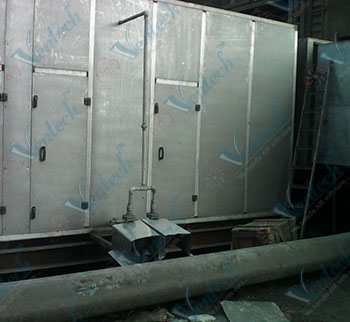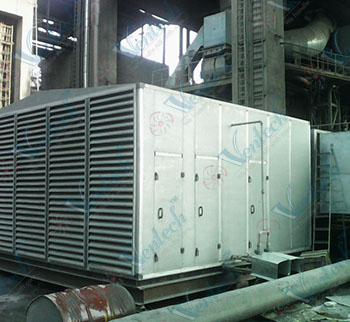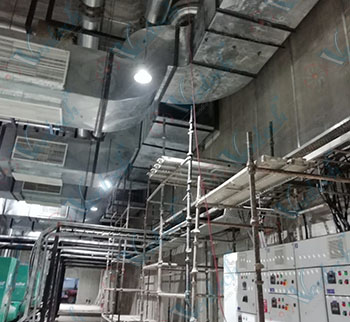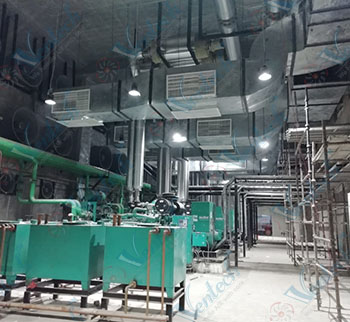The unsatisfactory past practices to providing exhaust ventilation without giving thought as to how the outdoor replacement air is to be provided has resulted in worker discomfort, damage to the costly and sophisticated equipments consequently the impaired in-plant environment in an industry. A present day awareness of this considers the need of providing suitable make up air systems by means of efficiently designed ventilation systems. The consideration of these factors will result in personnel comfort as well as a safe, controlled and dust free atmosphere.
Natural ventilation can seldom be satisfactory unless outside conditions are ideal and that rarely happens. A natural supply of fresh air depends upon the difference between the inside and outside temperatures. Fresh air will not flow naturally into a building unless a breeze is blowing in the direction, even then its distribution through an occupied space is a matter of chance. Nor will warm vitiated air flow out of the building unless the outside air is cooler than inside. Consequently, natural ventilation is least effective in a hot windless weather. Furthermore, there can be no defective control on the ingress of the dust inside the building spaces in the incoming air. Therefore, forced ventilation systems are necessary in most cases and in this context, three different systems may be employed as under:-
- 1. Extraction/ Exhaust of air
- 2. Supply of air
- 3. Combination of Extraction and supply
While properly designed exhaust systems alone will remove the contaminants of the inside air stream, they should not be relied upon to draw fresh air into the department space since this arrangement will cause a negative pressure in the building and may lead to many undesired results. Mechanical air supply systems are preferred and, in most cases, necessary in order to achieve the desired ventilation performance..
Thus it can, therefore, be seen that the term pressurization is better related to the methods of ventilation at (2) and (3) above.
- Supply Air System:-
- In this system fresh air is blown into an occupied space by means of fans and the used air flows out through any available outlets due to pressurization effect. The advantages of the supply air systems are that fresh air is introduced into the occupied space in a positive manner and a reasonable control can be maintained over its distribution besides the process of recirculating interior air can be more conveniently achieved. In addition, the air pressure within the building which is slightly above that of the outside atmosphere, tends to prevent infiltration of outside air. For obtaining good distribution of fresh air it is necessary to provide uniform arrangement of air outlets.
- Combination of Exhaust and Supply Systems:-
- The fullest control of ventilation is achieved by using both supply and exhaust systems. Uniform distribution of fresh air supply can then be ensured and used air could be let out at convenient points according to the design requirements. Under such systems the input fans should be selected to give about 20% more air volume than the exhaust fans, thereby keeping the atmosphere in the building at higher pressure than outside and reducing the ill effects of infiltration due to dust and other air-borne contaminants.
- The majority of outside air supply systems in use are installed only for replacement of air, often with little regard to the in-plant environmental control purposes i.e. to supply the required degree of air cleanliness, temperature and /or humidity control of air volume, velocity & temperature is necessary for a satisfactory working environment. A properly designed and installed air supply system can provide both replacement air and environmental control, and finds a ready relevancy in the type of industry, namely, pharmaceutical, electronics, control rooms in large power houses/ process industry, machine rooms and so on.
- The objective for creating pressurization effect inside any Industrial building space is, therefore to achieve the dust proofing which in majority of the cases is the process requirement and can be better accomplished by clearing the incoming air and conditioning wherever required. The degree of air cleanliness depends much upon the requirement of the process being carried out in an industry and can be achieved by employing a suitable filter media like HEPA, MICROVEE, HDPE etc, having varied degree of efficiency.
- A fresh supply of air from outside into the work place in factories where the thermal conditions are worsened by heat generated from machinery and process will help in relieving the thermal stress from the indoor conditions. However, in environments of extreme dry heat in northern part of the country, cooling the air before it is let into the industrial building not only relieves thermal stresses but also acts as an additional means of filtering the dusty stream of incoming air. In humid work places where the air temperature is below or approaches the body temperature, ventilator measures by promotion of air velocity will facilitate evaporative heat loss and result in reduction of the heat stress. Influence of the air velocity in maintaining thermal balance of the body has been found during the determination of various heat stress indices. A study carried out in this respect indicated that forced ventilation of the order of 60m/min would not result in any physiological stress in the Indian workers even in the situation where high temperatures of the order of 43 Deg. C and low humidity prevail.
- It has also been found that the wet bulb temperature is a more reliable index while considering upper limits of tolerance of heat as during certain periods of the hot season as in north, when outside wet bulb temperature of the atmosphere is high, inside conditions would not permit human comfort, nor even meet the relief cooling. During such periods the body heat dissipation due to processes of conduction, convection and radiation comes practically to a standstill, hence all the metabolic heat has to be lost by the process of evaporation only. However, there too, due to specific requirements of elevated relative humidity for efficient production, the evaporation process is also unsatisfactory. The only solution therefore is that the velocity of the air surrounding the human body is to be sufficiently increased to bring some comforts or the relief cooling.
- 1. That the evaporative coolers have average saturating efficiency of +70% and the cooled air enters the departments without prior heat gain.
- 2. That cooled air induces a minimum indoor air velocity of 1 m/sec.
- 3. That cooled air gains in temperature of at least 3-4oC indoors before its discharge.
- 4. That cooled spaces average at least 4-5oC below outdoor dry bulb temperature to counter-act entering radiant heat and provide a differential below the outside.
As already mentioned earlier, in the environments of extreme high heat there would be need for cooling the air before it is let into the work places, the evaporative cooling has been found to be an economical means for solving such problems. In general, evaporative cooling is found better where outside wet bulb temperature seldom rises above 25°C. however, to have proper ventilation effect for comfort evaporative cooling, the minimum requirements are:-
In humid inside climates and for very large premises, general technique for cooling emphasize “Spot Cooling” to minimise overall cost of the plant. In this system, duct and adjustable air outlets direct the evaporatively cooled air at each work station preferably striking the occupants at velocities from 2 to 5 m/sec. depending upon the local air outlets should be adjustable for the convenience of the workers. In all blow cooling systems adequate fresh air ventilation is essential. In small buildings, overhead exhaust fans can remove the used air and fresh air drawn in through open windows or doors. In large buildings “push-pull” ventilation is used to supply positively fresh air in and to exhaust out the spent and warm air.
- CONCLUSION:-
- Certain norms which could be followed to make an Industrial Evaporative Cooling Cum Pressurization Plant successful are below:-
- 1. Minimise external heat loads by shading, reflective painting, insulating etc.
- 2. Minimise internal heat loads by shielding, reflective painting, insulating and providing exhaust fans over each hot process.
- 3. Use all fresh air with no recirculation.
- 4. Use grille velocities of 6-8 m/sec. to induce maximum air movements.
- 5. Calculate necessary evaporatively cooled air volume from known heat loads, avoiding the basis of air changes per hour for industrial applications.
- 6. For pressurization effect, the crackage area should be kept minimum by sealing all the unnecessary openings in order to economise on the plant capacity.
- 7. Avoid vigorous evaporative cooling in particular rooms for offices and laboratories, where high indoor air velocities are not permissible.
- 8. For open large enclosures use spot-cooling for people at their work stations and not general room evaporative cooling.







